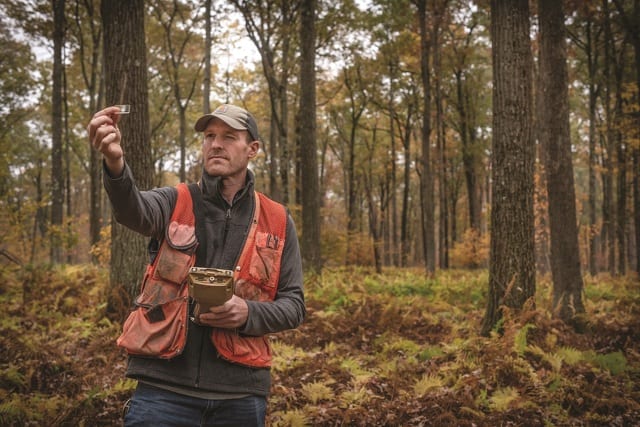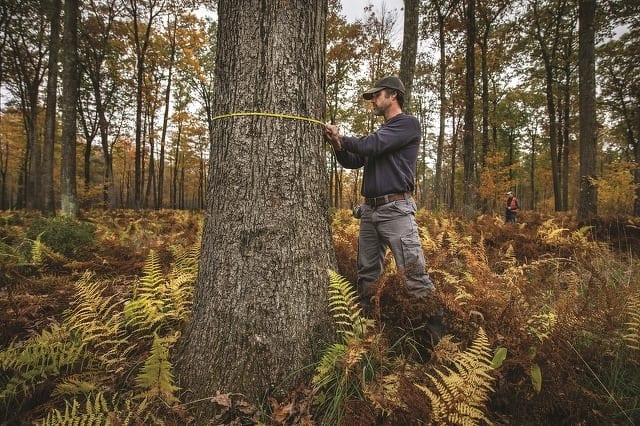Central Pennsylvania is a paradise for outdoors men and women. And though it may seem contrary to the wild, untamed nature of the world so many of us enjoy in our local state forests, these places are made to flourish through the meticulous intervention of the often-overlooked people behind the foliage who manage our public woodlands.
Responding to a crisis
Beginning in 2006, the Black Moshannon division of Moshannon State Forest in Centre County experienced an outbreak of gypsy moths. The invasive species defoliate trees (they eat the leaves), leaving them stressed and more prone to death. For the next two years, the infestation intensified and spread.
“Their favorite host is oak trees, and we had nearly unbroken stands of oak before the gypsy moths’ defoliation, so we had a lot of mortality,” says Scott Kucharcik, timber management forester of Centre County’s division of Moshannon State Forest. “We had upwards of 20,000 acres with heavy mortality. In some areas, 90 percent of the trees were dead, in other areas, 50 percent of the oaks had died.”
In 2009, the Moshannon State Forest forestry staff began accelerating their scheduled timber harvests in the Black Moshannon Division to salvage the dead and dying trees resulting from the repeated defoliation by gypsy moths.
“One of the missions of the Bureau of the Forestry is to provide sustainable quality timber for the logging industry, among many other things, providing wildlife habitat, protecting the water,” Kucharcik says. “So we have always done some timber sales, but never on this scale and never this condensed, with sale after sale. We didn’t have a choice. We didn’t want everything to rot, die, fall over – it’s bad for hikers and hunters. We decided it’s better to salvage the wood and get the value out of it, create habitat, and provide forest products.”
According to Brian Salvato, assistant district forester, a normal sustainable harvest allocation for the Black Moshannon Division is around 400 acres, “but because of the mortality, we had to go up to almost 3,000 acres a year.”
So far, the foresters have done salvage cuts to nearly half of the Black Moshannon division; 17,652 of approximately 40,000 total acres have been salvaged.
The salvaging process works generally like this: The foresters take inventory of a section of forest. They lay out the sale by walking it and marking the boundary, develop a prescription based on data collected, and send out a prospectus with estimates of timber volumes and value to logging companies and mills. Once the timber is sold, the foresters are responsible for administering the sale, making sure logging crews follow the specifications of the contract, cut only designated trees, and ensure soil disturbance and residual tree damage is minimal.
The more valuable timber is used locally or sent overseas to be made into furniture, barrels for high-end alcohol, etc., and mid- and lower-grade wood may be used to make such things as railroad ties, pallets, matting for gas wells and construction sites, and paper.
Millions of new trees planted
Salvaging dead timber has been just half the battle facing the foresters in the aftermath of the gypsy moth outbreak. Ideally, stands are regenerated naturally with seed from mature hardwoods such as oak, maple, and cherry in this area. In some places, however, the destruction was so bad that there was no seed source left by which trees could regenerate.
“Sometimes we’ll have 400,000 trees or more we want planted in one year,” Salvato says. “You only have a planting window of about a month. You have to have these seedlings in the ground between April and May; May 15th is pushing it.”
This is where the contract tree planters come in.
Moshannon State Forest has taken a cue from national forests and private forestry companies in the western and southern United Sates who employ teams of contract planters on work visas who are known for being extremely efficient at planting trees.
“In Guatemala or Mexico, to come here and get paid to plant seedlings … it’s a highly sought-after job,” says Doug Mohney, timber management forester.
“They’re very disciplined,” Salvato says. “If they get this job, they don’t want to lose it. They fly!”
The planters employ a specialized tool called a “hoedad” by which they dig a hole with one hand, grab a seedling from their bag, plant it, step on the earth to pat it down, take a few steps, and repeat the process in a day-long rhythm.
Each planter aims “for about 3,000 trees a day,” says Lance Jovenitti, timber management forester, noting that the teams of 10-12 people average about 30,000 trees total planted in a single day.
From 2010 to 2018, 3.8 million trees were planted in the Black Moshannon division of Moshannon State Forest.

(Photo by Darren Andrew Weimert) Scott Kucharcik, timber management forester the for Centre County Division of Moshannon State Forest, uses a prism to help determine which trees to cut.
Diverse habitats for all users
The foresters’ job is a complex one that must account for all the living species that make use of the forest – man, beast, and plant – while also contending with the whims of Mother Nature. If the foresters allowed nature to take its course, Kucharcik says the Black Moshannon division of Moshannon State Forest would be composed of standing dead timber, mountain laurel, fern, and thick, relatively valueless sassafras.
“It would definitely be a lot worse for wildlife and for people, because you can’t even walk through it,” says Kucharcik.
The foresters have been thoughtfully regenerating the forest, diversifying an environment that was once dominated by oak with an assortment of tree species to make it more desirable. Prior to the gypsy moths, the Black Moshannon division had a mere 3,356 acres of conifers. Now, there are an additional 5,600 acres of conifers, with a mix of white pine, white spruce, red pine, pitch pine, and Norway spruce. The forestry staff have also planted several apple orchards and maintain numerous food plots and herbaceous openings for wildlife that were created from salvage operations.
“We try to take a negative and turn it into a positive and do some good for wildlife and hunters and try to keep the aesthetics as much as we can,” Kucharcik says.
“We treat these woods as if they were our own,” Mohney says.
For those wondering why they see log-truck traffic more often than they think they should, it’s part of the process. Once seedlings are established and grow to a healthy level – meaning they’re thick enough that the foresters know they’ll regenerate – they enter the forest for a second cut.
Because of their rapid and resourceful response to the gypsy moth outbreak, the Moshannon State Forest forestry team has created a presentation relating to their experience to help other state forests manage similar crises.
Teresa Mull is a freelance writer in Philipsburg.



